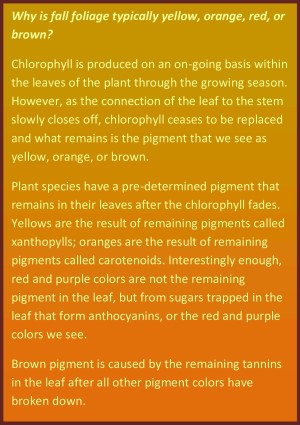While many of us learned long ago that the splendid fall color in leaves is created by a loss of chlorophyll, the colors left behind depend upon a number of factors. Plant species, temperature, growing conditions and more, all play a role in the colors we see in the autumn landscape. Let’s explore why we are going to see some phenomenal fall foliage this week.
What signals the plant to change?
Like many other processes in plants, the amount of daylight and dark determine when the colors will begin to change. The shorter days and longer nights signal to the plant to begin closing off the connection between stem and leaf, called the “abscission“ layer.
Because day-length is a predictable cycle through the year, the optimal weeks for viewing foliage are known from year to year. So although we can predict when the leaves will change, quality of the colors is not always known since it is affected by climate.
How does climate affect color?
The amount of rainfall, sunlight, and day or evening temperatures affect the quality of the color and often, how long the leaves will hang around. This year, we are anticipating fantastic fall color due to a combination of the moist growing conditions earlier in the year, the ongoing warm, sunny days, and the cool nights without frost. According to the United States National Arboretum, other combinations of factors that affect color are:
• Abundant sunlight and low temperatures after the time the abscission layer forms cause the chlorophyll to be destroyed more rapidly.
• Cool temperatures, particularly at night, combined with abundant sunlight, promote the formation of more anthocyanins [red and purple pigment].
• Freezing conditions destroy the machinery responsible for manufacturing anthocyanins, so early frost means an early end to colorful foliage.
• Drought stress during the growing season can sometimes trigger the early formation of the abscission layer, and leaves may drop before they have a chance to develop fall coloration.
• A growing season with ample moisture that is followed by a rather dry, cool, sunny autumn that is marked by warm days and cool but frostless nights provides the best weather conditions for development of the brightest fall colors.
 • Lack of wind and rain in the autumn prolongs the display.
• Lack of wind and rain in the autumn prolongs the display.
• Wind or heavy rain may cause the leaves to be lost before they develop their full color potential.
Making the most of fall colors on your property:
Unfortunately, you cannot control the climate, so to encourage the best fall foliage possible on your property try a few of these tips:
• Select species that are known for their fall foliage. Steer away from invasive species like Burning Bush, and get the classic yellow, orange, and red foliage from native species like Dwarf Fothergilla (Fothergilla gardenii), Sugar Maple (Acer saccharum), and Smooth Witherrod (Viburnum nudum), respectively. For more ideas on fall color, check out our article “Alternatives for Autumn Interest”.
• Install plants in proper growing conditions. Extreme conditions stress plants and stressed plants can form the abscission layer prematurely, so identify the types of growing conditions present on your property and select plants to fit those conditions.
• Plan for the best fall color in sunnier areas. Although we don’t recommend removing shade trees for the sole purpose of getting better fall color, keep in mind that if your fall color lacks year after year, it may be because your plants are in too shady of a location. Rather than removing shade plants, try elevating some lower limbs or selectively pruning upper branches to allow more light into your gardens.
References and additional resources:
Interactive Fall Foliage Map (SmokyMountains.com)
Science of Color in Autumn Leaves (United States National Arboretum)
Why leaves change color, Northeastern Area (USDA Forest Service)

